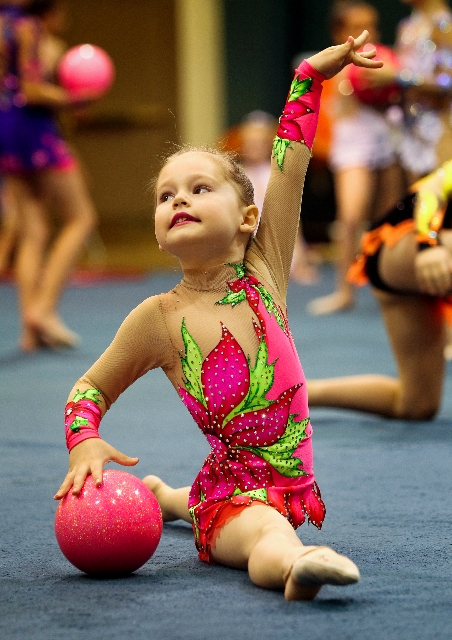Rhythmic gymnastics gaining toehold with Summerlin club
Out of the mouths of 8-year-old athletes sometimes come pearls — including the word “apparatus.”
That word is interchangeable with “prop” when describing the balls, hoops, ropes, ribbons and clubs used in rhythmic gymnastics, an Olympic sport since 1984.
In Las Vegas, 8-year-olds Isabelle Richardson and Sara Parker giggle but roll their tongues easily over the word “apparatus” while chasseing through super-disciplined weekly routines, private sessions with contortion coaches and ballet training, often five days a week.
Both are scoping out the path to the Olympics through a Summerlin club called EuroGymnastics, with help from world-traveling Bulgarian coaches and world competition and medal winners. The club is the only one of its kind in Nevada.
This weekend, the club hosted the third annual Rhythmic Gymnastics Tournament at the Mirabelli Community Center. Three hundred gymnasts from Australia, Argentina, Canada, El Salvador, Mexico, Russia, Ukraine, Uzbekistan, Vietnam and Japan competed, proving that Nevada is no stranger to the competitive rhythmic gymnastics world.
The Las Vegas team fared well in the event. Parker finished first in her age group. Richardson, who is on the road to the nationals, took first in every event, including all-around in her age group.
Unlike artistic gymnastics, which has captured the American imagination with Herculean shows of strength on the balance beam, rhythmic gymnastics combines ballet and dance. It’s more expressive, according to EuroGymnastics meet director B.B. Ignatova.
“If a rhythmic gymnast in Bulgaria and an artistic gymnast, they’re walking side by side, you can always tell which one is which one,” said Svetelina Tabakova, a former rhythmic gymnast national team member and Bulgaria native.
Tabakova and her sister Maia, a national team member, Olympic medalist and “Zumanity” performer in Las Vegas, started the local program at Ignatova’s request.
While rhythmic gymnasts thrive in Bulgaria, Russia and Europe in general, the U.S. is just awakening to the sport. And, while Bulgarians at the national team level practice approximately six or more hours a day, young American athletes often get half that time in the gym.
“The kids there are just trained beyond reason,” said Jeanie Richardson, Isabelle’s mother, who took her daughter to summer training camp last year in Bulgaria, where rounds of six-hour training without air conditioning were the norm.
Ignatova had an idea three years ago about how to overcome the American lack of awareness and the limitations for American rhythmic gymnasts: Bring the rest of the world to Las Vegas.
“Las Vegas is a very attractive destination,” Ignatova said. “Probably if we have a competition here, we will bring girls from across the world to America, so that our girls will be able to compete with girls who are on a higher level and with more experience and have more potential. I thought, what is a better place than Las Vegas?”
Starting a small program was the natural next step.
The Tabakova sisters transcended the obstacles here by recruiting locally among those who most appreciate the sport — walking into Eastern European stores with fliers and spreading the word among local performers. From a handful of Russian and Bulgarian girls — and a few whose parents perform in Cirque Du Soleil — the program has grown to more than 30 students.
“They walk in the gym, and I don’t even have to say anything,” Tabakova said proudly. “They right away form one big line. I do a snap of fingers and point toward the direction they need to start running, and they start running.”


















